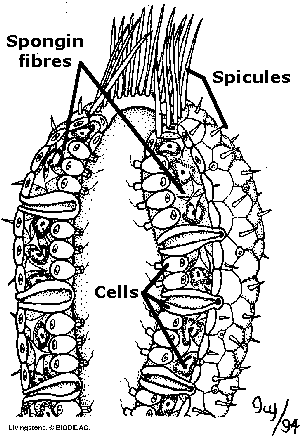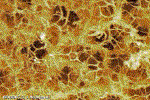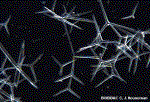 Above: Diagram of the structure of a typical sponge |  Above: Photograph of |
 Above: Photograph of |
| MadSci Network: Biophysics |
Mario Llige asked:
Why are sponges stiff when they are dry, but soft and floppy when they are wet? (I'm not sure if this pertains to biophysics, but that's my guess. Thanks for any answer you can give me. It's been puzzling me for years.)
Well, the first thing to realise is that, of course, a dry sponge is a dead sponge. A soft and floppy wet sponge is probably a living (or at least fairly recently living) sponge.
The second thing to realise is that when some sponges go from being alive to being dead, they disappear, or disintigrate, almost entirely. Others, as you know, are tossed up on the shore where they dry out and persist for a long time.
The difference, and the answer to your question, can be understood by knowing a bit about the anatomical structure of sponges. In general, a sponge's body is constructed of three types of materials: cells, spicules and spongin. The cells form the living tissue of the sponge and are the parts responsible for feeding, growth and reproduction. These cells have the same basic components as our own cells, although their structure and function is rather different.
 Above: Diagram of the structure of a typical sponge |  Above: Photograph of |
 Above: Photograph of |
Spongin is a fibrous material, similar to the collagen which is found in the connective tissues of all animals. It forms a fine, meshlike support for the sponge cells. Spicules are small silicon or calcium carbonate elements--often shaped like tiny stars, rods or crosses--which are embedded in the sponge's body and provide additional protection and support (in some sponges these actually stick a short way out of the animal's body and give its surface a rough feel).
All sponges have cells, since these form the living tissue, but species differ in the amount of spongin, and number and size of spicules. Sponges with few spicules and little spongin will simply disintegrate when they die and their tissues decay.
When sponges with few spicules but substantial amounts of spongin die, the cells will break down leaving the spongin framework. This may loose some flexibility as the fibres dry out but should not become completely stiff.
The very stiff sponge skeletons are from those species which have numerous (probably large) spicules embedded in the body. When the spongin fibres dry, the whole skeleton will become fairly rigid. Species which do not have much spongin may still form a rigid skeleton because the spicules themselves may be glued together.
Finally, you should remember that anything washed up on a beach will have sea salt dried on and in it, and this will also tend to stiffen the structure.
Here's a couple of sites you can visit to learn more about these simple, but abundant, animals:
Hope this helps – Keith McGuinness, Northern Territory University.